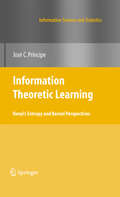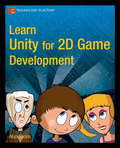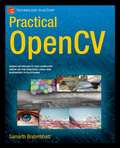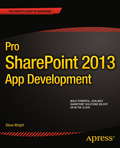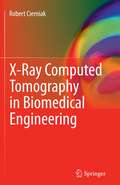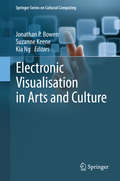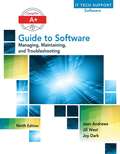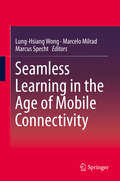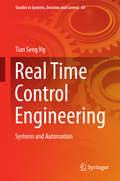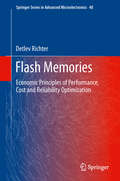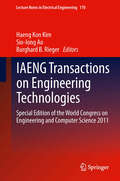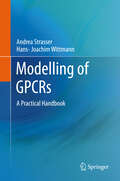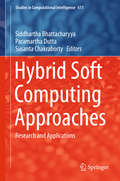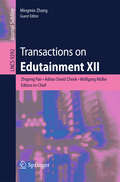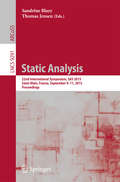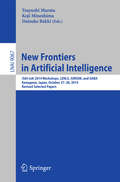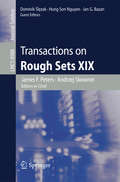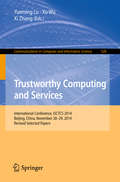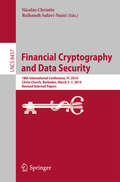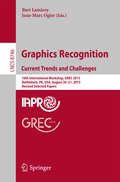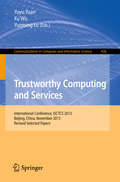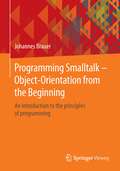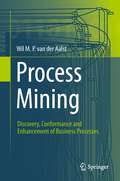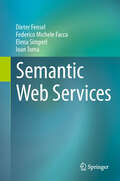- Table View
- List View
Information Theoretic Learning
by Jose C. PrincipeThis book presents the first cohesive treatment of Information Theoretic Learning (ITL) algorithms to adapt linear or nonlinear learning machines both in supervised or unsupervised paradigms. ITL is a framework where the conventional concepts of second order statistics (covariance, L2 distances, correlation functions) are substituted by scalars and functions with information theoretic underpinnings, respectively entropy, mutual information and correntropy. ITL quantifies the stochastic structure of the data beyond second order statistics for improved performance without using full-blown Bayesian approaches that require a much larger computational cost. This is possible because of a non-parametric estimator of Renyi's quadratic entropy that is only a function of pairwise differences between samples. The book compares the performance of ITL algorithms with the second order counterparts in many engineering and machine learning applications. Students, practitioners and researchers interested in statistical signal processing, computational intelligence, and machine learning will find in this book the theory to understand the basics, the algorithms to implement applications, and exciting but still unexplored leads that will provide fertile ground for future research.
Learn Unity for 2D Game Development
by Alan Thorn2D games are everywhere, from mobile devices and websites to game consoles and PCs. Timeless and popular, 2D games represent a substantial segment of the games market. In Learn Unity for 2D Game Development, targeted at both game development newcomers and established developers, experienced game developer Alan Thorn shows you how to use the powerful Unity engine to create fun and imaginative 2D games. Written in clear and accessible language, Learn Unity for 2D Game Development will show you how to set up a step-by-step 2D workflow in Unity, how to build and import textures, how to configure and work with cameras, how to establish pixel-perfect ratios, and all of this so you can put that infrastructure to work in a real, playable game. Then the final chapters show you how to put what you've already made to work in creating a card-matching game, plus you'll learn how to optimize your game for mobile devices. What you'll learn How to create a 2D workflow in Unity Customizing the Unity Editor How to generate atlas textures and textured quads Animation effects and camera configuration Handling user input Creating a game from start to finish Optimizing for mobile devices Who this book is for Game development students and professionals, indie developers, game artists and designers, and Unity developers looking to improve their workflow and effectiveness. Table of Contents 1. Unity Basics for 2D Games 2. Materials and Textures 3. Quick 2D Workflow 4. Customizing the Editor with Editor Classes 5. Procedural Geometry and Textured Quads 6. Generating Atlas Textures 7. UVs and Animation 8. Cameras and Pixel Perfection 9. Input for 2D Games 10. Getting Started with a 2D Game 11. Completing the 2D Card Game 12. Optimization 13. Wrapping Things Up
Practical OpenCV
by Samarth BrahmbhattPractical OpenCV is a hands-on project book that shows you how to get the best results from OpenCV, the open-source computer vision library. Computer vision is key to technologies like object recognition, shape detection, and depth estimation. OpenCV is an open-source library with over 2500 algorithms that you can use to do all of these, as well as track moving objects, extract 3D models, and overlay augmented reality. It's used by major companies like Google (in its autonomous car), Intel, and Sony; and it is the backbone of the Robot Operating System's computer vision capability. In short, if you're working with computer vision at all, you need to know OpenCV. With Practical OpenCV, you'll be able to: Get OpenCV up and running on Windows or Linux. Use OpenCV to control the camera board and run vision algorithms on Raspberry Pi. Understand what goes on behind the scenes in computer vision applications like object detection, image stitching, filtering, stereo vision, and more. Code complex computer vision projects for your class/hobby/robot/job, many of which can execute in real time on off-the-shelf processors. Combine different modules that you develop to create your own interactive computer vision app. "
Pro SharePoint 2013 App Development
by Steve WrightApps have taken the world by storm, and now they're taking SharePoint as well. The biggest new thing in SharePoint 2013, apps are the solution to creating custom code that runs on not just your own SharePoint deployment, but also on others' implementations as well. Pro SharePoint 2013 App Development is your must-have guide to developing app solutions that run on the SharePoint 2013 platform. Using step-by-step tutorials, authorSteve Wrightcreates a sample SharePoint app throughout the course of the book, and you can walk with him through the entire lifecycle of a SharePoint app. Get expert guidance and advice on creating an app, provisioning it for use in SharePoint, securing it from unauthorized use and from other applications, integratingyour app with SharePoint search and other platform features, and much more. You'll even discover how to present your app to users on mobile devices like iPads, smartphones, and Microsoft Surface tablets. Apps in SharePoint are here to stay. Don't miss out - pick up a copy of Pro SharePoint 2013 App Development and get started on your own custom apps today. Introduces the architecture for creating and hosting SharePoint apps. Leads the reader through the creation and deployment of a complete solution. Provides an understanding of the security features in the SharePoint app model. Helps the organization leverage internal data securely over the network. Leverages SharePoint search and other services to create rich SharePoint solutions. Introduces the techniques for delivering data on a multitude of web and mobile platforms. "
X-Ray Computed Tomography in Biomedical Engineering
by Robert CierniakComputed Tomography gives a detailed overview of various aspects of computed tomography. It discusses X-ray CT tomography from a historical point of view, the design and physical operating principles of computed tomography apparatus, the algorithms of image reconstruction and the quality assessment criteria of tomography scanners. Algorithms of image reconstruction from projections, a crucial problem in medical imaging, are considered in depth. The author gives descriptions of the reconstruction methods related to tomography scanners with a parallel X-ray beam, trough solutions with fan-shaped beam and successive modifications of spiral scanners. Computed Tomography contains a dedicated chapter for those readers who are interested in computer simulations based on studies of reconstruction algorithms. The information included in this chapter will enable readers to create a simulation environment in which virtual tomography projections can be obtained in all basic projection systems. This monograph is a valuable study on computed tomography that will be of interest to advanced students and researchers in the fields of biomedical engineering, medical electronics, computer science and medicine.
Electronic Visualisation in Arts and Culture
by Jonathan P. Bowen Kia Ng Suzanne KeenePresenting the latest technological developments in arts and culture, this volume demonstrates the advantages of a union between art and science. Electronic Visualisation in Arts and Culture is presented in five parts: Imaging and CultureNew Art PracticeSeeing MotionInteraction and Interfaces Visualising HeritageElectronic Visualisation in Arts and Culture explores a variety of new theory and technologies, including devices and techniques for motion capture for music and performance, advanced photographic techniques, computer generated images derived from different sources, game engine software, airflow to capture the motions of bird flight and low-altitude imagery from airborne devices. The international authors of this book are practising experts from universities, art practices and organisations, research centres and independent research. They describe electronic visualisation used for such diverse aspects of culture as airborne imagery, computer generated art based on the autoimmune system, motion capture for music and for sign language, the visualisation of time and the long term preservation of these materials. Selected from the EVA London conferences from 2009-2012, held in association with the Computer Arts Society of the British Computer Society, the authors have reviewed, extended and fully updated their work for this state-of-the-art volume.
Comp TIA A+ Guide to Software: Managing, Maintaining, and Troubleshooting
by Jean Andrews Joy Dark Jill WestThis step-by-step, highly visual text provides a comprehensive introduction to managing and maintaining computer hardware and software. Written by best-selling author and educator Jean Andrews, A+ Guide to Software, Ninth Edition closely integrates the CompTIA A+ Exam objectives to prepare students for the 220-902 certification exam. The new Ninth Edition also features extensive updates to reflect current technology, techniques, and industry standards in the dynamic, fast-paced field of PC repair and information technology. Each chapter covers both core concepts and advanced topics, organizing material to facilitate practical application and encourage students to learn by doing. The new edition features more coverage of security, virtualization, new coverage of cloud computing, Linux and Mac OS, and increased emphasis on mobile devices. Supported by a wide range of supplemental resources to enhance learning with Lab Manuals, CourseNotes, online labs and the optional MindTap that includes labs, certification test prep and interactive exercises and activities, this proven text offers students an ideal way to prepare for success as a professional IT support technician.
Seamless Learning in the Age of Mobile Connectivity
by Lung-Hsiang Wong Marcelo Milrad Marcus SpechtThe book departs from the approach of related titles by focusing on describing and reflecting upon the notion of seamless learning with regard to salient characteristics of learner mobility and bridging of learning experiences across learning spaces. It is the first such work that is solely dedicated to research on and the practice of seamless learning, uniquely combining interpretations, visions, and past research on and practices in seamless learning from diversified perspectives. The book also strikes a good balance between theoretical and practical perspectivess, going beyond a collection of reports on specific research projects. Instead of thick descriptions of research processes and findings, readers will find significant insights and food for thought intended to inspire further advances in the research on and practice of seamless learning.
Real Time Control Engineering
by Tian Seng NgThis book covers the two broad areas of the electronics and electrical aspects of control applications, highlighting the many different types of control systems of relevance to real-life control system design. The control techniques presented are state-of-the-art. In the electronics section, readers will find essential information on microprocessor, microcontroller, mechatronics and electronics control. The low-level assembly programming language performs basic input/output control techniques as well as controlling the stepper motor and PWM dc motor. In the electrical section, the book addresses the complete elevator PLC system design, neural network plant control, load flow analysis, and process control, as well as machine vision topics. Illustrative diagrams, circuits and programming examples and algorithms help to explain the details of the system function design. Readers will find a wealth of computer control and industrial automation practices and applications for modern industries, as well as the educational sector.
Geoscience Research and Outreach: Schools and Public Engagement
by Vincent C. TongFrom energy and water resources to natural disasters, and from changing climatic patterns to the evolution of the Earth's deep interior, geoscience research affects people's lives in many ways and on many levels. This book offers a stimulating cross-disciplinary perspective on the important relationship between geoscience research and outreach activities for schools and for the general public. The contributors - academics, research scientists, science educators and outreach program educators - describe and evaluate outreach programs from around the world. A section entitled Field-based Approaches includes a chapter describing an initiative to engage Alaskan communities and students in research, and another on problem-based learning in the field setting. The Online Approaches section discusses ways to connect students and scientists using online forums; use of the web and social media, including the United Nations University and its experience with the design of a web magazine featuring geoscience research; and video clips on marine geoscience created by students and scientists. The section on Workshop and Laboratory-based Approaches includes a chapter on teaching geochronology to high school students, and another describing an extracurricular school activity program on meteorology. The Program Design section presents chapters on Integrating Geoscience Research in Primary and Secondary Education, on ways to bridge research with science education at the high school level, and on use of online geoscience data from the Great Lakes. The concluding section, Promoting Research-enhanced Outreach, offers chapters on Geoscience Outreach Education with the local community by a leading research-intensive university, and on the use of research to promote action in Earth science professional development for schoolteachers.Geoscience Research and Outreach: Schools and Public Engagement will benefit geoscience researchers who wish to promote their work beyond academia. It offers guidance to those seeking research funding from agencies, which increasingly request detailed plans for outreach activities in research proposals. Policymakers, educators and scientists working in museums, learned societies and public organizations who wish to widen participation will also find this book useful. Together with the companion volume Geoscience Research and Education: Teaching at Universities, this book showcases the key role that geoscience research plays in a wide spectrum of educational settings.
Flash Memories
by Detlev RichterThe subject of this book is to introduce a model-based quantitative performance indicator methodology applicable for performance, cost and reliability optimization of non-volatile memories. The complex example of flash memories is used to introduce and apply the methodology. It has been developed by the author based on an industrial 2-bit to 4-bit per cell flash development project. For the first time, design and cost aspects of 3D integration of flash memory are treated in this book. Cell, array, performance and reliability effects of flash memories are introduced and analyzed. Key performance parameters are derived to handle the flash complexity. A performance and array memory model is developed and a set of performance indicators characterizing architecture, cost and durability is defined. Flash memories are selected to apply the Performance Indicator Methodology to quantify design and technology innovation. A graphical representation based on trend lines is introduced to support a requirement based product development process. The Performance Indicator methodology is applied to demonstrate the importance of hidden memory parameters for a successful product and system development roadmap. Flash Memories offers an opportunity to enhance your understanding of product development key topics such as: · Reliability optimization of flash memories is all about threshold voltage margin understanding and definition; · Product performance parameter are analyzed in-depth in all aspects in relation to the threshold voltage operation window; · Technical characteristics are translated into quantitative performance indicators; · Performance indicators are applied to identify and quantify product and technology innovation within adjacent areas to fulfill the application requirements with an overall cost optimized solution; · Cost, density, performance and durability values are combined into a common factor - performance indicator - which fulfills the application requirements
IAENG Transactions on Engineering Technologies
by Sio-Iong Ao Burghard B. Rieger Haeng Kon KimThis volume contains thirty revised and extended research articles written by prominent researchers participating in an international conference in engineering technologies and physical science and applications. The conference serves as good platforms for the engineering community to meet with each other and to exchange ideas. The conference has also struck a balance between theoretical and application development. The conference is truly international meeting with a high level of participation from many countries. Topics covered include chemical engineering, circuits, communications systems, control theory, engineering mathematics, systems engineering, manufacture engineering, and industrial applications. The book offers the state of art of tremendous advances in engineering technologies and physical science and applications, and also serves as an excellent reference work for researchers and graduate students working with/on engineering technologies and physical science and applications.
Modelling of GPCRs
by Andrea Strasser Hans-Joachim WittmannG protein coupled receptors (GPCRs) comprise an important protein family, which is involved in signal transduction in the cell. Besides that a large number of drugs, available on market, address GPCRs. For an efficient and improved development of appropriate drugs, molecular modelling of GPCRs is - in order to understand the ligand-receptor interactions and functionality of GPCRs on molecular level - an important tool. The book "Modelling of GPCRs - a practical handbook" is focussed onto a practical introduction into molecular modelling of GPCRs. This book is very useful for beginners in GPCR modelling, but also addresses the advanced GPCR modeller: On the one hand, the book introduces principles of GPCR modelling, including extensive examples. On the other hand, detailed outlooks onto advanced GPCR modelling techniques are presented. Furthermore, the book includes important data, like information about crystal structures in a summarized manner or amino acid sequences, which are essential for GPCR modelling in general. Due to an increase in efficacy and data handling most modellers use LINUX as operating system. To address this, a summary of most important LINUX commands with examples is presented within the book.
Hybrid Soft Computing Approaches
by Siddhartha Bhattacharyya Paramartha Dutta Susanta ChakrabortyThe book provides a platform for dealing with the flaws and failings of the soft computing paradigm through different manifestations. The different chapters highlight the necessity of the hybrid soft computing methodology in general with emphasis on several application perspectives in particular. Typical examples include (a) Study of Economic Load Dispatch by Various Hybrid Optimization Techniques, (b) An Application of Color Magnetic Resonance Brain Image Segmentation by Para Optimus LG Activation Function, (c) Hybrid Rough-PSO Approach in Remote Sensing Imagery Analysis, (d) A Study and Analysis of Hybrid Intelligent Techniques for Breast Cancer Detection using Breast Thermograms, and (e) Hybridization of 2D-3D Images for Human Face Recognition. The elaborate findings of the chapters enhance the exhibition of the hybrid soft computing paradigm in the field of intelligent computing.
Transactions on Edutainment XI
by Zhigeng Pan Adrian David Cheok Wolfgang Mueller Mingmin ZhangThis journal subline serves as a forum for stimulating and disseminating innovative research ideas, theories, emerging technologies, empirical investigations, state-of-the-art methods, and tools in all different genres of edutainment, such as game-based learning and serious games, interactive storytelling, virtual learning environments, VR-based education, and related fields. It covers aspects from educational and game theories, human-computer interaction, computer graphics, artificial intelligence, and systems design. The 24 papers presented in this 11th issue were organized in four parts dealing with: object reconstruction and management; graphics; VR/AR; and applications.
Static Analysis
by Sandrine Blazy Thomas JensenThis book constitutes the refereed proceedings of the 22nd International Static Analysis Symposium, SAS 2015, held in Saint-Malo, France, in September 2015. The 18 papers presented in this volume were carefully reviewed and selected from 44 submissions. All fields of static analysis as a fundamental tool for program verification, bug detection, compiler optimization, program understanding, and software maintenance are addressed, featuring theoretical, practical, and application advances in the area
New Frontiers in Artificial Intelligence
by Daisuke Bekki Tsuyoshi Murata Koji MineshimaThis book constitutes the thoroughly refereed post-conference proceedings of the JSAI-isAI 2014 Workshops LENLS, JURISIN, and GABA which tool place on November 2014, in Japan. The 26 contributions in this volume were carefully reviewed and selected from 57 submissions. From the 3 workshops (LENLS11, JURISIN2014, and GABA2014), 23 papers were carefully selected and revised according to the comments of the workshop program committee. LENLS (Logic and Engineering of Natural Language Semantics) is an annual international workshop on formal semantics and pragmatics and it focused on the formal and theoretical aspects of natural language. JURISIN (Juris-informatics) 2014 was the 8th event in the series, the purpose of this workshop was to discuss fundamental and practical issues for juris-informatics, bringing together experts from a variety of relevant backgrounds, including law, social science, information and intelligent technology, logic and philosophy (including the area of AI and law). GABA (Graph-based Algorithms for Big Data and its Applications) 2014 was the first workshop on graph structures including string, tree, bipartite- and di-graph for knowledge discovery in big data. The purpose of this workshop was to discuss ideas for realizing big data integration, including algorithms with theoretical / experimental results.
Transactions on Rough Sets XIX
by James F. Peters Andrzej Skowron Hung Son Nguyen Dominik Ślȩzak Jan G. BazanThe LNCS journal Transactions on Rough Sets is devoted to the entire spectrum of rough sets related issues, from logical and mathematical foundations, through all aspects of rough set theory and its applications, such as data mining, knowledge discovery, and intelligent information processing, to relations between rough sets and other approaches to uncertainty, vagueness, and incompleteness, such as fuzzy sets and theory of evidence. Volume XIX in the series focuses on the current trends and advances in both the foundations and practical applications of rough sets. It contains 7 extended and revised papers originally presented at the Workshop on Rough Set Applications, RSA 2012, held in Wroclaw, Poland, in September 2012. In addition, the book features 3 contributions in the category of short surveys and monographs on the topic.
Trustworthy Computing and Services
by Xi Zhang Xu Wu Yueming LuThis book constitutes the refereed proceedings of the International Standard Conference on Trustworthy Computing and Services, ISCTCS 2014, held in Beijing, China, in November 2014. The 51 revised full papers presented were carefully reviewed and selected from 279 submissions. The topics covered are architecture for trusted computing systems; trusted computing platform; trusted system building; network and protocol security; mobile network security; network survivability, other critical theories and standard systems; credible assessment; credible measurement and metrics; trusted systems; trusted networks; trusted mobile networks; trusted routing; trusted software; trusted operating systems; trusted storage; fault-tolerant computing and other key technologies; trusted e-commerce and e-government; trusted logistics; trusted internet of things; trusted cloud and other trusted services and applications.
Financial Cryptography and Data Security
by Nicolas Christin Reihaneh Safavi-NainiThis book constitutes the thoroughly refereed post-conference proceedings of the 18th International Conference on Financial Cryptography and Data Security (FC 2014), held in Christ Church, Barbados, in March 2014. The 19 revised full papers and 12 short papers were carefully selected and reviewed from 165 abstract registrations and 138 full papers submissions. The papers are grouped in the following topical sections: payment systems, case studies, cloud and virtualization, elliptic curve cryptography, privacy-preserving systems, authentication and visual encryption, network security, mobile system security, incentives, game theory and risk, and bitcoin anonymity.
Graphics Recognition. Current Trends and Challenges
by Bart Lamiroy Jean-Marc OgierThis book constitutes the thoroughly refereed post-conference proceedings of the 10th International Workshop on Graphics Recognition, GREC 2013, held in Bethlehem, PA, USA, in August 2013. The 20 revised full papers presented were carefully reviewed and selected from 32 initial submissions. Graphics recognition is a subfield of document image analysis that deals with graphical entities in engineering drawings, sketches, maps, architectural plans, musical scores, mathematical notation, tables, and diagrams. Accordingly the conference papers are organized in 5 topical sessions on symbol spotting and retrieval, graphics recognition in context, structural and perceptual based approaches, low level processing, and performance evaluation and ground truthing.
Trustworthy Computing and Services
by Yuyu Yuan Xu Wu Yueming LuThis book constitutes the refereed proceedings of the International Standard Conference on Trustworthy Distributed Computing and Services, ISCTCS 2013, held in Beijing, China, in November 2013. The 49 revised full papers presented were carefully reviewed and selected from 267 papers. The topics covered are trustworthy infrastructure; security, survivability and fault tolerance; standards, evaluation and certification; trustworthiness of services.
Programming Smalltalk - Object-Orientation from the Beginning
by Johannes BrauerA straightforward, step-by-step introduction to clear and elegant object-oriented programming. Using a language that's perfect for this kind of programming, the book has been tested in numerous courses and workshops over ten years. Programming Smalltalk is particularly suited for readers with no prior programming knowledge. Starting from the first principles of programming, it teaches you how to use and create algorithms (reusable rules for problem-solving) and the basic building blocks of software. It goes on to explain how to develop complete applications and has a whole chapter on web applications as well as case studies. Now translated into English, this edition was completely revised to be consistent with the latest version of Cincom® VisualWorks®, a professional Smalltalk environment. All examples were created using VisualWorks, which is available without cost for educational purposes, and can be downloaded and installed on any up-to-date computer.
Process Mining
by Wil M. van der AalstThe first to cover this missing link between data mining and process modeling, this book provides real-world techniques for monitoring and analyzing processes in real time. It is a powerful new tool destined to play a key role in business process management.
Semantic Web Services
by Dieter Fensel Elena Simperl Federico Michele Facca Ioan TomaA paradigm shift is taking place in computer science: one generation ago, we learned to abstract from hardware to software, now we are abstracting from software to serviceware implemented through service-oriented computing. Yet ensuring interoperability in open, heterogeneous, and dynamically changing environments, such as the Internet, remains a major challenge for actual machine-to-machine integration. Usually significant problems in aligning data, processes, and protocols appear as soon as a specific piece of functionality is used within a different application context. The Semantic Web Services (SWS) approach is about describing services with metadata on the basis of domain ontologies as a means to enable their automatic location, execution, combination, and use. Fensel and his coauthors provide a comprehensive overview of SWS in line with actual industrial practice. They introduce the main sociotechnological components that ground the SWS vision (like Web Science, Service Science, and service-oriented architectures) and several approaches that realize it, e.g. the Web Service Modeling Framework, OWL-S, and RESTful services. The real-world relevance is emphasized through a series of case studies from large-scale R&D projects and a business-oriented proposition from the SWS technology provider Seekda. Each chapter of the book is structured according to a predefined template, covering both theoretical and practical aspects, and including walk-through examples and hands-on exercises. Additional learning material is available on the book website www.swsbook.org. With its additional features, the book is ideally suited as the basis for courses or self-study in this field, and it may also serve as a reference for researchers looking for a state-of-the-art overview of formalisms, methods, tools, and applications related to SWS.
